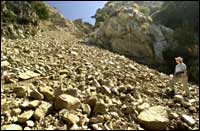
Reporter Becky Oskin looking at about twenty thousand of cubic yards of debris dumped in Rubio Canyon. (Staff photo by Walt Mancini)

 Reporter Becky Oskin looking at about twenty thousand of cubic yards of debris dumped in Rubio Canyon. (Staff photo by Walt Mancini) |